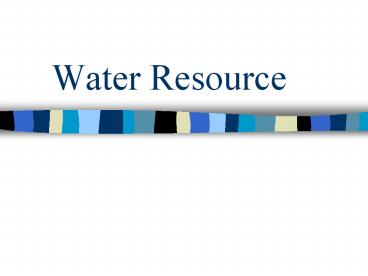Water Resource - PowerPoint PPT Presentation
1 / 21
Title: Water Resource
1
Water Resource
2
(No Transcript)
3
(No Transcript)
4
(No Transcript)
5
(No Transcript)
6
(No Transcript)
7
(No Transcript)
8
(No Transcript)
9
Total Withdrawal 134,000 Mgal/day Surface water
63 Groundwater 37 Irrigation Use 39 of all
freshwater withdrawal
10
- Total withdrawal increased from 1950 to 1980 and
has held steady since then although population
has increased by 16 - Withdrawal for thermoelectric power generation
190,000 Mgal/day largest of any other category - Higher water price, more public awareness,
conservation, better farming and industrial
techniques will keep water demand in check
11
- Hydroelectric water use 3,160,000 Mgals/day
- 2.6 times annual run-off
- Same water is used several times by a series of
dam on the same river - Instream use water is returned to the stream
- Almost all withdrawal is from fresh surface water
12
(No Transcript)
13
The High Plains Aquifer
- The High Plains is a 174,000-square-mile area of
flat to gently rolling terrain that includes
parts of eight States from South Dakota to Texas.
The area is characterized by moderate
precipitation but in general has a low
natural-recharge rate to the ground-water system.
Unconsolidated alluvial deposits that form a
water-table aquifer called the High Plains
aquifer underlie the region. During the late
1800s, settlers and speculators moved to the
plains, and farming became the major land-use
activity in the area. Since that time, irrigation
water pumped from the aquifer has made the High
Plains one of the Nations most important
agricultural areas. - Over the years, the intense use of ground water
for irrigation in the High Plains has caused
major water-level declines and decreased the
saturated thickness of the aquifer significantly
in some areas. For example, in parts of Kansas,
New Mexico, Oklahoma, and Texas, ground-water
levels have declined more than 100 feet
14
Changes in ground-water levels in the High Plains
aquifer from before ground-water development to
1997. (V.L. McGuire, U.S. Geological Survey,
written commun., 1998.)
15
The Gulf Coastal Plain Aquifer System
- The Gulf Coastal Plain aquifer system consists of
a large and complex system of aquifers and
confining units that underlie about 290,000
square miles extending from Texas to westernmost
Florida, including offshore areas to the edge of
the Continental Shelf. - Water withdrawals from the aquifer system have
caused - lowering of hydraulic heads at and near pumping
centers - reduced discharges to streams, lakes, and
wetlands - induced movement of saltwater into parts of
aquifers that previously contained freshwater - and caused land subsidence in some areas as a
result of the compaction of interbedded clays
within aquifers.
16
Land subsidence in Houston
17
The Colorado River flows through Utah to Lake
Powell, thence through the northwest corner of
Arizona to Lake Mead. From Hoover Dam it flows
southward to Mexico forming the border between
Nevada, California and Arizona, and yielding
major diversions to central Arizona and southern
California. The river is the lifeblood of the
southwestern US and its development and
management have been the focus of attention by
the member states for more than a century. Waters
of the Colorado River System have been
apportioned by a treaty with Mexico, compacts,
and a Supreme Court decree to the seven basin
states.
Colorado River basin
18
- The Colorado River flows through Utah to Lake
Powell, thence through the northwest corner of
Arizona to Lake Mead. From Hoover Dam it flows
southward to Mexico forming the border between
Nevada, California and Arizona, and yielding
major diversions to central Arizona and southern
California. The river is the lifeblood of the
southwestern US and its development and
management have been the focus of attention by
the member states for more than a century. Waters
of the Colorado River System have been
apportioned by a treaty with Mexico, compacts,
and a Supreme Court decree to the seven basin
states.
19
Colorado River Compact
- The Colorado River Compact of 1922 divided the
use of waters of the Colorado River System
between the Upper and Lower Colorado River Basin.
- It apportioned in perpetuity to the Upper and
Lower Basin, respectively, the beneficial
consumptive use of 7.5 million acre feet (maf) of
water per annum. - It also provided that the Upper Basin will not
cause the flow of the river at Lee Ferry to be
depleted below an aggregate of 75 maf for any
period of ten consecutive years. - The Mexican Treaty of 1944 allotted to Mexico a
guaranteed annual quantity of 1.5 maf. These
amounts, when combined, exceed the river's
long-term average annual flow.
20
Within Colorado water allocations are based on
the Doctrine of Prior Appropriation or the
First-in-Time, First-in-Right Doctrine. This
doctrine is found in most arid states because
when there is too little water to satisfy all
users, sharing of the remaining water would be of
little value to any user
21
Water Rights
- Riparian Rights (Eastern USA)
- Every landowner can make reasonable use of lake
or stream or water flowing through or bordering
his property - Municipalities have the right of eminent domain
at times of scarcity, cities get their
requirement first - Sale of riparian rights allowed in some states
- Practical in regions of plentiful water
22
Law of Prior Appropiation
- First come, first served
- Settlers can lay claim to certain amount of water
which will be honored for perpetuity - The oldest claim are honored first and any left
over goes to the next claimant and so on.. - Los Angeles bought up water rights in 1900 from
areas far and wide, some even from Arizona. Now
people in those areas are very unhappy about the
arrangement































